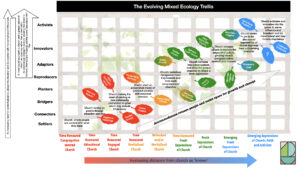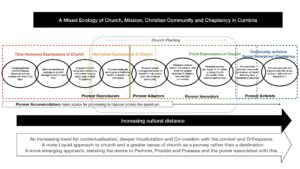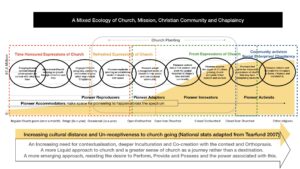As I reflect on the journey of Fresh Expressions and the broader movement for systems change over the last ten years in Cumbria, it’s too easy to point to growth which to be honest is a pretty shallow measure of numbers usually driven by institutional anxiety. I think it is better to talk about scale. There is a great article a friend Katie sent me https://systemsanctuary.com/scale-deep that has been really helpful in my thinking as I prepare to move on. The language of scale isn’t just about getting bigger, it’s about how change spreads, embeds, and transforms. Drawing on insights from the systems change field, particularly the work referenced in the Systems Sanctuary paper, we can distinguish three distinct types of scale: scaling out, scaling up, and scaling deep
Scaling out refers to replicating and spreading innovations across new communities or contexts. In the context of the church, this looks like launching more Fresh Expressions in different towns, villages, or networks, essentially multiplying what works so that more people can benefit from it.
Scaling up is about influencing policies, structures, and systems to support and sustain change. For the church, this means embedding the principles of Fresh Expressions into diocesan strategies, clergy training, and church governance. In other words, it’s about changing the “rules of the game” so that the whole system supports and nurtures innovation.
Scaling deep focuses on transforming cultural values, relationships, and ways of being. This is about changing hearts, minds, and everyday practices. In the church, scaling deep means shifting the culture to be more open, inclusive, and embrace more of the lived experience of those it is serving.
These three forms of scale; out, up, and deep, work together to create lasting systems change, but it is scaling deep that ensures the change is truly embedded in the life and culture of the church. Research shows that large-scale, lasting systems change requires a combination of all three types of scaling. Scaling out ensures more people benefit, scaling up makes change stick but scaling deep is what transforms the culture and relationships at the heart of the church. It’s about changing the stories we tell, the ways we relate, and the values we embody, especially for those who have experienced exclusion or trauma.
Those who know me well, know that my upbringing was far from straight forward, and my lived experience of ACE’s will always play a role in how I look at the world, and work in systems. A few years ago I noticed this can play out in two ways. One where the institutions remain in a role of an abusive parent who fails to listen and change or a healthier way where the institution can embrace the gift of trauma informed practice and someone’s gift of resilience and stickability in the difficult space of the institution to help bring real change. I have to say on the whole my experience with the church in Cumbria has been good but there have been far more difficult times when my bounce back abilities have seriously waned. What kept me going and sane in those times were the pioneer and and fx networks and systems within the system that had been trauma-informed, nurtured deep belonging and spiritual transformation because they are made up and for those who have been on the margins. As I wrote in the poem a few weeks ago They are the muscles of hope not wishbone or whisper, but sinew and tendon that flexes beneath the skin with every reimagined dream of a better world
I guess my question, concern and challenge as I leave is have we scaled deep enough at leadership levels and who and how will the voice of the margins be brought to the centre. I was so privileged to usually have good relationships with senior leaders and until our structures more recently changed be in right meetings at the right times to bring the my lived experience and that of our pioneers to the table.
Too often, organisations treat lived experience as a box to tick, a story for the annual report, a voice on a panel. But centring lived experience is not about tokenism; it’s about transformation. When people with lived experience are involved early and meaningfully in decision-making, service design, and governance, the work changes. It becomes more responsive, more just, and more effective.
This requires trust, time, and a willingness to be changed by what we hear. It means building relationships, closing the feedback loop, and being honest about the influence that lived experience will have on decisions. I think institutions also need to be honest about potential risk it is to the individuals contributing and the damage that could be caused.
The challenge is to keep scaling out and scaling up, but never at the expense of scaling deep. There is another blogpost needed here because the funding in the CofE is mainly oriented towards scaling out and as I say that’s a pretty shallow approach, but also it’s one that in the long term threatens real systems change. Only by listening to and centring the lived experience of those on the margins can we hope to nurture a mixed ecology of church that is truly renewed, inside and out.



